Application of Bituminous Membrane
Application of Bituminous Membrane
- Home
- Water Proofing
- Waterproofing Products
- Bitumen Membrane
- Application of Bituminous Membrane
Application of Bituminous Membrane
Waterproofing is a critical step in the construction of any structure. There are many types of waterproofing membranes and their application depends on several factors including the use of the structure and the construction process. Waterproofing is often seen in the building of houses (basements, foundation, roof underlayment, kitchen , bathroom etc), parking structures, and patios.
Waterproofing can also be seen in specialized applications such as shower stalls, bathroom floors, mechanical rooms, pools, and planter boxes. Saltwater and marine applications have specific requirements since they must be able to withstand the corrosion from salt, sand, and wave action.
1. Foundation Waterproofing
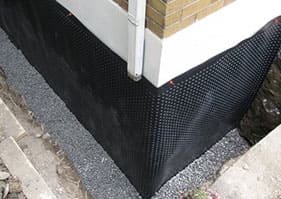
The foundation is the most important aspect in a structure; one should take all possible measures to ensure its longevity. The strength and life of the house are directly dependent on the foundation. The most prominent and concerning problems are dampness and water logging. The moisture in the soil around the foundation that later seeps into the basement and provides an ideal environment for mold formation.
A horizontal barrier on the wall structure and its purpose are to stop moisture to rise from the foundation into the structure. This layer is put between layers of walls and is to be applied in both the partition walls and the load-bearing wall.
Process
- Clean and dampen the horizontal open surface, 15 cm above the highest ground level nearby (level to which water splashes)
- Mix Cement, Concrete and a Suitable Waterproofing compound in the ratio 1:1.5:3
- Apply a layer of at least 25 mm thickness
- After the mixture hardens – Apply the sealant solution layer (x1) horizontally and after a 4 hour period (1x) vertically
- This is to be applied to the full width, along all the walls of the Foundation
2. Basement Waterproofing
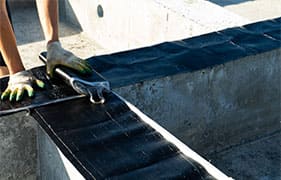
The Basement that requires the most attention because water can cause major problems. Water can crawl into wall spaces and create a wet damp condition causing molds. This leads to an unpleasant foul smell inside the building. If this issue is left unattended, water logging scenario, this can cause property damage inside basements and poses a great threat to the electrical systems which is commonly based on the lower levels. The lift mechanism system faces threat from this causing rusting and total failure. Overall, the whole infrastructure will fail due to these hazard conditions.
Two methods used in basement waterproofing is the Positive (application on the same side of hydro-static pressure) and the Negative (application on the opposite side of water pressure) waterproofing.
- Positive Waterproofing: In this method, the surrounding perimeters to the building structure is dug – about a meter deep(depends) and layers of waterproofing solution is applied (horizontal x1, vertical x1). This is the best suggested way to protect since the major cause of the problem is water pressure from the outside during monsoons.
- Negative Waterproofing: Cautions must be taken that the materials used are not permeable and do not form honeycomb structures. This application is not very reliable because when the water seeps in, the proofing layer is not always flexible enough to adhere that much pressure.It has been a trend by many contractors to use this method because of the ease and faster application.
3. Kitchen, Toilet and Bathroom Waterproofing
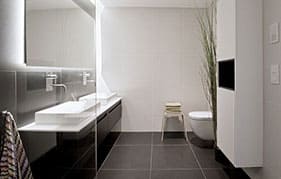
The walls and the floors are wet all the time in one way or another. Since these rooms are adjacent to each other, water leaks through one room will ruin the other rooms and their property. The essential thing here is that water only flows through drain pipes. Waterproofing during construction will ensure you will never have to face any issues later.
Waterproofing is generally needed in shower stalls, bath areas, laundries, bathrooms in general, wet areas in kitchens, around all penetration areas (e.g. taps, drains).
Precautions
- Protect finished work from traffic until fully cured.
- Do not apply directly to Damp Surfaces.
- Do not use on wood or metal surfaces.
- Use mechanical support, when required.
- Grouting should not be done for at least 24 hours.
- Store the membrane in a cool and dry place.
- When fixing the waterproofing membrane ensure that corners should be fixed first, followed by fillet joints and the horizontal area.
4. Terrace Garden
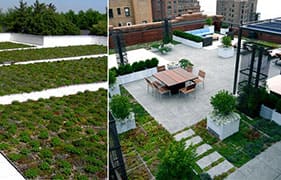
Terrace area of the building has to endure the most of nature’s harsh weather, climate, and heat. Monsoon plays a major part in this. The heat of the sun causes the rigid surface to expand – causing cracks. Moreover, People nowadays like to make gardens on the terrace which adds up to the problem of water leakage issues. Also called, roof garden, living roof green roof, the primary roof construction must be based on concrete grout and flexible waterproofing polymers. This is a highly effective service that helps to keep the terrace garden clean as well as moisture-free.
Layers
- Layer 1 – 30mm Foam shield – Sand cement and foam mixed in a special mixing device.
- Layer 2- (x2- Coat – Horizontal/Vertical) Roof Sealant Liquid Adhesive based solution. Dries up to form a highly elastic membrane.
- Layer 3- Geo-Textile Fabric– This separates water from the soil so that soil does not drain away.
- Layer 4- Concrete Screed – Smooth layer of concrete/cement – sand – 1.3.1. Slope gradient 1:100 (slope towards the drains to collect excess water).
- Layer 5- Pyro(Heat) Torch Shield Primer – Creates a layer for proper adhesion of the Torch Shield membrane.
-
Layer 6- Pyro Torch Shield (Anti root) Membrane (x2- Coat – Horizontal/Vertical) – Modified bitumen based membrane. Heated by gas blow torches to activate the adhesion that sticks to layer 5. The Anti root membrane is safe from the roots of the plants.
- Layer 7- Drain Boards – This is a proper channel for excess water in the soil to drain out. Soil filter at the end of the drain.
- Geo Textile Fabric – These are permeable fabrics which, when used in association with soil, have the ability to separate, filter, reinforce, protect drain clogging.
5. Swimming Pool
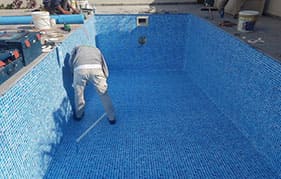
Swimming Pools is constantly exposed to humidity. Wet areas waterproofing or under tile waterproofing is required in order to avoid serious damage to the structure of the pool. Swimming pool waterproofing system, can completely waterproof the pool/fountain prior to tiling, to create a secure waterproofed environment and offer long term protection for the building/ structure.
Elastomeric type of waterproofing to be directly applied to its substrates, which has an ability to resist cracking.
If you opt to use waterproofing and crack isolation membrane, follow these steps:
- Smooth the Substrate
- Clean the Substrate
- Apply the Waterproofing Membrane
- Test for Leaks
6. Bridges

To increase the durability of reinforced concrete bridges, all concrete movement and construction joints, plus the bridge decks have to be waterproofed to prevent serious damage to the concrete, or to the embedded steel reinforcement. Due to dynamic loading, the bridge decks must be protected with elastic, crack-bridging systems to accommodate any movement and maintain the protection.
The waterproofing has to be sufficiently robust to resist transient vehicle loading, maintain good adhesion to the deck and the surfacing and possess long-term durability.
Advantages
- Elastic, crack-bridging properties, especially at low temperatures
- Resistance to chlorides and automotive chemicals such as fuel, oils and hydraulic fluids.
- Easy to install and accommodate variations in level and substrate conditions
- Fast application to reduce traffic closure times.
7. Parking Areas
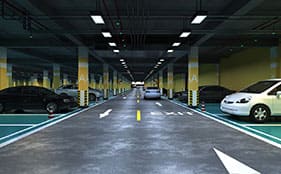
Protecting the surface of concrete trafficked areas in structures designed for parking cars and vehicles is extremely important in order to preserve their functionality and durability to maintain a high level of safety and minimize maintenance costs.
To protect trafficked areas on the lowest underground floors it is not necessary to guarantee the flexibility and crack-bridging capacity of the system because there is a limited risk of the floor slabs suffering from structural failure.
The intermediate floors must offer protection against mechanical wear and aggressive chemicals, and also prevent de-icing salts from penetrating into them, but the movements due to expansion and contraction of the substrate are less compared with the top floor.
Advantages
- Chemical resistance, protection against contamination by fuels and oils
- Coloured surface design for improved orientation
- System-integrated detail waterproofing on upstands, junctions and kerbs
- Seamless security for joints, where cracks occur and transitions
- Full-surface fleece reinforcement for waterproofing parking decks, ramps and driveways